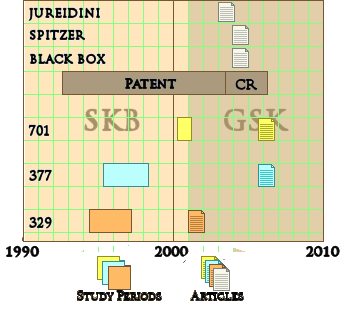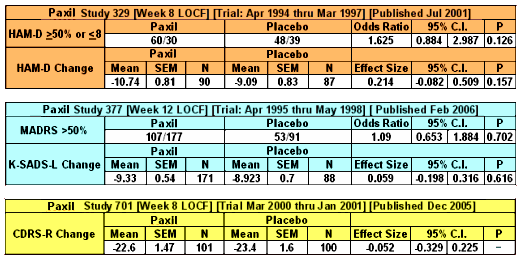[Note: the Press coverage of our article is on study329.org, but I wanted to mention the article on Retraction Watch because it has Dr. Martin Keller’s response to our paper with an argument similar to the one below…]
14 OCT 1998Please find attached to this memo a position piece, prepared by Julie Wilson of CMAT, summarising the results of the clinical studies in Adolescent Depression.
As you will know, the results of the studies were disappointing in that we did not reach statistical significance on the primary end points and thus the data do not support a label claim for the treatment of Adolescent Depression. The possibility of obtaining a safety statement from this data was considered but rejected. The best which could have been achieved was a statement that, although safety data, was reassuring, efficacy had not been demonstrated. Consultation of the Marketing Teams via Regulatory confirmed that this would be unacceptable commercially and the decision to take no regulatory action was recently endorsed by the TAT.
As you will see from the position piece the positive trends In efficacy which were seen in Study 329 are being published as a poster at ECNP this year and a full manuscript is in development. Published references will therefore be available for the study. There are no plans to publish data from Study 377.
This report has been prepared for internal use only. Data on File summaries will be prepared and issued once the final reports from the studies have been approved. This position piece will also be available on the Seroxat/Paxil resource database.
TARGET [from the Wilson position piece mentioned above]
To effectively manage the dissemination of these data in order to minimize any potential negative commercial impact…
Paroxetine is generally well tolerated and effective for major depression in adolescents.
This study was designed at a time when there were no randomized controlled trials showing antidepressant [tricyclic antidepressant or SSRI] superiority to placebo, so we had no prior data from which to astutely pick our outcome measures. The field has moved strongly away from using the Hamilton Rating Scale for Depression [HAM-D] in adolescent treatment studies and has gone virtually uniformly to using the Children’s Depression Rating Scale-Revised because the latter better and more reliably captures aspects of depression in youth. Surely a national regulatory body charged with approving or not approving a medication for a particular use might well simply say that if a study does not show efficacy on the primary endpoint[s[, it is a failed study and secondary outcome measures cannot then be used for approval. However, as scientists and clinicians we must adjudge whether or not the study overall found evidence of efficacy, and we do not have the convenience of falling back on such a simple rule. If we choose wrongly [in whichever direction], we don’t treat depressed children as well as the data would permit. Because we found a clear pattern of significant p values across multiple secondary analyses [recovery as assessed by HAM-D < 8, HAM-D depressed mood item, the Schedule for Affective Disorders and Schizophrenia for School-Age Children depression item, and Clinical Global Impression score at endpoint], we thought and still think this provides significant evidence of efficacy of paroxetine compared with placebo in adolescent depression. Without established reliable measures that distinguish medication responders from nonresponders at the time the study was designed, it is not surprising that the primary measures did not reach significance while other measures did. It still provides a strong “signal” for efficacy…


by Ray Berard, Regan Fong, David J. Carpenter, Christine Thomason, and Christel WilkinsonJournal of Child and Adolescent Psychopharmacology. 2006 16[1-2]:59–75.…Conclusions: No statistically significant differences were observed for paroxetine compared with placebo on the two prospectively defined primary efficacy variables. Paroxetine at 20–40 mg/day administered over a period of up to 12 weeks was generally well tolerated.
by GRAHAM J. EMSLIE, KAREN DINEEN WAGNER, STAN KUTCHER, STAN KRULEWICZ, REGAN FONG, DAVID J. CARPENTER, ALAN LIPSCHITZ, ANDREA MACHIN, AND CHRISTEL WILKINSONJournal of the American Academy of Child and Adolescent Psychiatry. 2006 45[6]:709-719.…Conclusions: Paroxetine was not shown to be more efficacious than placebo for treating pediatric major depressive disorder.
The article by Keller et al. [2001] is one of only two to date to show a positive response to selective serotonin reuptake inhibitors [SSRIs] in child or adolescent depression. We believe that the Keller et al. study shows evidence of distorted and unbalanced reporting that seems to have evaded the scrutiny of your editorial process. The study authors designated two primary outcome measures: change from baseline in the Hamilton Rating Scale for Depression [HAM-D] and response [set as fall in HAM-D below 8 or by 50%]. On neither of these measures did paroxetine differ significantly from placebo. Table 2 of the Keller article demonstrates that all three groups had similar changes in HAM-D total score and that the clinical significance of any differences between them would be questionable. Nowhere is this acknowledged. Instead:
What difference does it make whether the failures of reporting in the 2001 Keller paper resulted from deceit or from abysmal poor tradecraft? Either way, they have lost our trust in their scientific credentials.
It was both spin and sin. The Bible says that the love of money is the root of all evil.
Congratulations to the team that finally brought the truth.